A Tribute to Dr. Joan Steitz
Throughout the annals of scientific history, few names shine as brightly as Dr. Joan Steitz. Renowned for her groundbreaking contributions to RNA biology, Joan’s illustrious career is a testament to her unwavering dedication, intellect, and pioneering spirit. Behind her remarkable scientific achievements is a person of immense warmth, compassion, and humility. Known for her down-to-earth demeanor and infectious enthusiasm, she has touched the lives of countless individuals, both within and beyond the scientific community. Those fortunate enough to have crossed paths with Joan speak of her generosity of spirit and unwavering support, qualities that have endeared her to colleagues and mentees alike. Her genuine interest in the well-being and success of others serves as a beacon of light in an often-competitive academic landscape.
What few people may know is that Joan has also been a pillar of The Jane Coffin Childs Memorial Fund for Medical Research, serving in several different roles for over fifty years. Joan was a JCC Fellow from 1969-1970, working in the lab of Dr. Bruce Ames at Berkeley, while her husband, Tom was finishing his JCC Fellowship (1967-1969). She later served on the Board of Scientific Advisors (BSA) for 19 years from 1983 to 2002. The last 11 years of that span she was also the Director of the BSA, guiding the scientific principles and rigor of the fund. Since 2008, Steitz has served as a member of the Board of Managers.
In addition to her formal roles with JCC, Joan has mentored legions of graduate students and postdocs in her lab, including several JCC Fellows and soon-to-be Fellows. Demonstrating her deep care for the JCC Fellows, Steitz established the Joan A Steitz Child Dependent Fund in 2008, using her prize money from the Gairdner award to create the fund. This Fund provides an additional stipend to all JCC Fellows with children to help offset childcare costs.
In this tribute to Joan we will explore the intricate and enduring relationship between Joan and JCC, looking at a lineage of four generations of JCC Fellows, starting with Steitz herself. Two of Steitz’ core principles shine through this lineage: (1) scientific excellence, and (2) an uncompromising commitment to mentoring and advocating for her trainees. Of course, these selected stories touch on only a fraction of the remarkable science Steitz has conducted and of her tremendous impact on generations of scientists.
A Lineage of Jane Coffin Childs Fellows
P0 – Dr. Joan Steitz
Steitz originally planned on attending medical school. However, those plans changed after a summer working in Dr. Joseph Gall’s lab at the University of Minnesota. There Steitz purified ciliary basal bodies, also known as kinetosomes, and visualized these structures using electron microscopy.
This summer research experience hooked Steitz on “the thrill of discovery”. She quickly turned down medical school in favor of a PhD program to further pursue this thrill. Steitz credits Gall with empowering her to take ownership of her scientific project, even though she was just an undergraduate student.
With her appetite for discovery whetted, Steitz went on to graduate school at Harvard University where she worked with Dr. James D. Watson and characterized bacteriophage RNA and protein molecules. The challenges facing women scientists at the time were extraordinary, as highlighted by Dr. Watson’s comment in Joan’s application “ So unlike many women who do science almost compulsively before marriage and then totally stop, Joan is likely to remain an active scientist for many years.”
After graduate school, Steitz moved to the Medical Research Council Laboratory of Molecular Biology at the University of Cambridge for her postdoc. At the MRC, Steitz applied her bacteriophage expertise to elucidate the initiator sequences that dictate the translational starting point on messenger RNA. Her breakthrough discovery revealed how ribosomes find the correct translational starting point, out of a slew of possible choices.
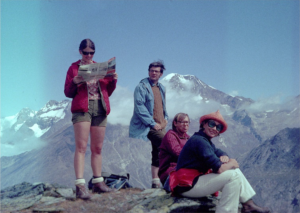
Joan looking at a map in the Swiss Alps. Also pictured are her husband Tom Steitz, also standing, as well as Jerry Adams and Suzanne Cory, sitting.
Steitz’ postdoctoral studies were funded by the National Science Foundation, and then by JCC. She notes that the JCC Fellowship was quite nice to have, as it paid her more than her advisor’s salary for that year!
Following her postdoc, Steitz started her own lab at Yale University. She credits Dr. Fred Richards for his forward-thinking recruitment. Many institutions only recruited Steitz’ husband Tom for a faculty position, yet, Yale was one of the few institutions that jointly recruited them to each run their own labs.
Over the decades Steitz has mentored numerous graduate students and postdocs. Together they have made important scientific discoveries in many aspects of RNA biology. Steitz aims to create an environment in her lab that encourages young scientists to seize ownership of their projects. Although Steitz still maintains that nothing beats the thrill of making a new scientific discovery oneself, she views mentoring a burgeoning scientist as they make their own discovery as the next best feat.
F1 – Dr. Rachel Mitton-Fry
Dr. Mitton-Fry received her PhD from the University of Colorado in Dr. Deborah Wuttke’s lab. There she determined the structural basis for an essential protein binding to single-stranded telomeric DNA. During her time at Colorado, Mitton-Fry was encouraged to present her research at the Colorado RNA Club. At first, she thought it was funny that they wanted her to present her research on single-stranded DNA. However, the RNA club reassured Mitton-Fry that single-stranded DNA was close enough!
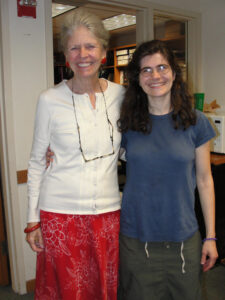
Joan and Rachel in the Steitz lab.
The RNA club must have rubbed off on Mitton-Fry as she next joined the Steitz lab to investigate RNA structure. During her postdoc, Mitton-Fry was pregnant with her second child. Already feeling stretched thin between juggling her lab work and taking care of one kid, Mitton-Fry thought she would not be able to continue her postdoc. She remembers feeling devastated at what seemed like the end of the road for her scientific career. She grieved the apparent loss of her long-term goal of being a professor at an undergraduate college.
Mitton-Fry tried breaking the news to Steitz, but Joan staunchly refused. “Now Rachel, you never leave a position – you take a leave of absence first”, Steitz advised. Mitton-Fry took the leave of absence when her second child was born. Mitton-Fry recalls “dragging her feet” as the leave came to an end. Together, Steitz and Mitton-Fry formulated a plan to continue her postdoc on a parttime basis. Mitton-Fry asked JCC to convert her Fellowship to parttime and was initially rebuffed as being a JCC Fellow was considered a fulltime job. However, after Steitz discussed the matter with JCC, they indeed converted the Fellowship to parttime. The three-year fellowship instead covered six years with half of the normal salary provided for each year.
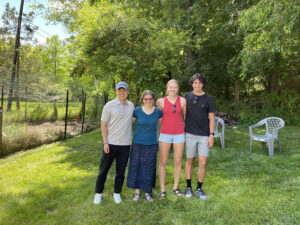
The Mitton-Fry lab including Rachel, second from left. Joan and Tom Steitz held joint lab barbeques. Rachel and her husband Mark continue the joint lab barbeque tradition.
Mitton-Fry thrived with this parttime arrangement. She demonstrated how a herpesvirus noncoding RNA forms a triple helix between an internal loop and the polyadenylation tail to prevent its decay by host nucleases. This was an especially exciting result because it definitively demonstrated a longstanding prediction in the RNA field. The presence of an RNA triple helix had been inferred by Dr. Alexander Rich studying poly(A) and poly(U) oligonucleotides in the 1950s. However, Mitton-Fry’s research was the first natural example of an intramolecular RNA triple helix between a U-rich internal loop and a poly(A) sequence, and provided keen insight into a biological function of this structure. Excitingly, a few examples have since been discovered of similar motifs stabilizing eukaryotic RNAs.
Dr. Mitton-Fry achieved her professional goal and is currently an Associate Professor of Chemistry and Biochemistry at Denison University, where she enjoys working directly with students in both the classroom and the lab.
Her lab investigates RNA thermometers. These temperature-regulated RNA structures control gene expression to ensure that pathogenic infections flourish within suitable environmental niches. Research at Denison is conducted with a distinct set of personnel and accessible experiments compared to Yale or Colorado. Yet, Mitton-Fry finds that these circumstances stimulate her to broaden the scientific scope of her research program and pursue novel scientific avenues. Mitton-Fry is currently piloting new studies on a sabbatical in Germany that will launch her and her students at Denison on their next research project.
F1 – Dr. Erik Sontheimer
One of Steitz’ graduate students, Erik Sontheimer, made key insights into pre-mRNA splicing during his time in the lab. Sontheimer used an elegant in vitro approach to investigate the roles of the small nuclear RNAs U1-U6 in RNA splicing. Using photoactivatable crosslinkers, Sontheimer provided insight into the order of snRNAs contributing to the splicing reaction and into possible conformational arrangements of the spliceosome.
Sontheimer remembers Steitz as a very committed mentor, and notes that this commitment continued even after he left her lab. He appreciates the freedom that Steitz gave to her trainees to figure many things out on their own, something he has tried to emulate as a mentor.
After graduating from Yale, Sontheimer moved to the University of Chicago where he was a JCC Fellow in Dr. Joseph Piccirilli’s lab. He continued studying RNA splicing, but altered his focus from the RNA splicing machinery to the chemical reaction itself with an emphasis on the catalyzing metal ions.
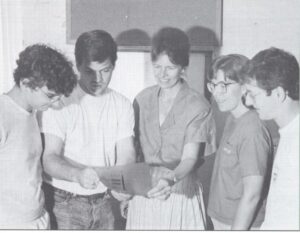
The Steitz lab including Joan, middle, and Erik, second from left.
As Sontheimer started his own lab at Northwestern University he continued studying RNA splicing. However, that arm of his research program was gradually replaced by examining other roles of RNA in gene expression. In Sontheimer’s view, his lab, like the Steitz lab, has a common thread of RNA biology that connects many different areas of investigation. He learned from Steitz that science is more fun, and success is more likely, if you stay in tune with new opportunities and aren’t afraid to shift into something new if it’s interesting and important. Now at the RNA Therapeutics Institute at the University of Massachusetts, Sontheimer and his lab continue to search out new and important approaches to interrogate the original nucleic acid.
That shift happened early in Sontheimer’s independent career as he started examining the gene silencing role of siRNAs and miRNAs in Drosophila melanogaster. He started hearing about another form of genetic interference: CRISPR gene silencing in bacteria. Sontheimer was interested in studying CRISPR in his own lab. However, at that point there was no one in his lab that worked on bacteria. So, he wasn’t sure how they would make the shift technically. That’s when Luciano Marraffini approached Sontheimer with the idea that he could study CRISPR as a postdoc in his lab.
F2 – Dr. Luciano Marraffini
Marraffini conducted his PhD research at the University of Chicago in Dr. Olaf Schneewind’s lab. There, Marraffini combined microbiology and biochemistry techniques to decipher the mechanisms of protein sorting to the cell wall in the bacteria Staphylococcus aureus.
Around this time, CRISPR gene interference systems were being reported in other bacteria. Marraffini was curious whether Staphylococcus also have CRISPR, and found evidence for such systems in their genome. He did a quick experiment to demonstrate that CRISPR was functionally important for preventing plasmid conjugation, thereby deterring antibiotic resistance from being transferred between bacterial cells.

Luciano pipetting in the Sontheimer lab.
Based on these exciting results, Marraffini approached Sontheimer and proposed doing a postdoc in his lab to elucidate the mechanism of CRISPR. Both view Marraffini joining the Sontheimer lab as an ideal case of synergy combining Marraffini’s microbiology skills with the Sontheimer lab’s expertise in genetic interference. Simply put, Sontheimer states that Marraffini was the “right postdoc at the right time” for this project.
Marraffini demonstrated that CRISPR silences gene expression by targeting DNA. At the time it was thought that CRISPR, like miRNAs and siRNAs, might silence gene expression at the mRNA level. However, Marraffini and Sontheimer cleverly introduced a self-splicing intron into the nickase gene that is targeted by Staphylococcus CRISPR systems. This self-splicing intron disrupts the CRISPR targeting sequence in the DNA of the nickase gene. In contrast, the targeting sequence is reassembled in the mature, spliced form of the mRNA. They found that insertion of the self-splicing intron disrupted CRISPR gene silencing. This result clearly demostrated that CRISPR was silencing gene expression by recognizing DNA, not mRNA!
Marraffini is thankful for the foundational training that he received in his PhD lab. Yet, he views receiving the JCC Fellowship, and the scientific discoveries that it supported, as the first time in his career that his research was broadly interesting beyond his scientific niche. Marraffini found that Sontheimer struck a nice balance in his mentoring approach. Sontheimer provided the freedom that is necessarily to allow creative science to unfold, yet still stayed engaged with his work. This balance helped Marraffini maintain focus on the most essential question in his project – the mechanism of how CRISPR works. Furthermore, Marraffini is grateful to JCC for supporting what at the time could have easily been viewed as a prokaryotic idiosyncrasy with dubious connection to human health.
This discovery launched Marraffini on his independent career and he started his own lab at The Rockefeller University. The Marraffini lab studies CRISPR systems mainly in their biological context. He notes that only one or two types of CRISPR are used for gene editing. Yet there are many different CRISPR variants in different bacteria, which makes for a very rich mine for extracting novel biological understanding.
F3 – Dr. Josh Modell
Initially, Josh Modell was interested in cancer biology. Modell worked as a technician in Dr. Todd Golub’s lab where he helped generate a “Connectivity Map” that connected the treatment of human cultured cells with bioactive small molecules. For example, this Map linked cancer drugs with the resulting changes in gene expression.
When Modell started as a graduate student at The Massachusetts Institute of Technology, he thought he would continue studying cancer biology. After two rotations in cancer labs, Modell rotated in Dr. Michael Laub’s lab. There, he was captivated by the elegant biology of the nonpathogenic bacteria Caulobacter crescentus. Modell investigated the Caulobacter cell cycle and provided molecular insights into a DNA damage checkpoint in his PhD research.
When Modell searched for postdoc labs he was open to working with any model organism. Ultimately, he ended up sticking with bacteria because he was drawn to the reduced and simple system of CRISPR in its native context in the Marraffini lab.
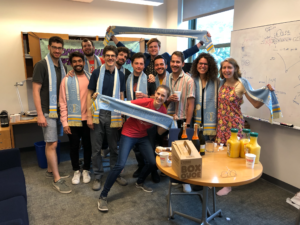
The Marraffini lab including Josh, far left, and Luciano, third from left.
CRISPR is a form of bacterial innate immunity against bacteriophage invaders. The bacterial host cell integrates segments of the bacteriophage DNA into the host genome. These “spacer sequences” are then transcribed into short RNA guides that direct CRISPR systems to destroy the invading phage genome.
However, it wasn’t known when integration of spacer sequences into the host genome occurs during the bacteriophage infection cycle. As a JCC Fellow, Modell demonstrated that these spacer sequences integrate into the host genome immediately after it’s injection into the bacterial cell, but surprisingly not during other stages of the viral cycle when free DNA ends are also available. These findings suggest that CRISPR systems take advantage of the phage life cycle to mount an immediate immune response.
Modell recalls the Marraffini lab as a very exciting place to conduct science. He credits Luciano with creating an enticing environment where people work very hard because they personally have high expectations for their own projects. Additionally, Modell fondly recalls lab movie viewings in Marraffini’s office. He marvels at how Marraffini was able to work with fútbol matches ever present on the tv in the background of his office.
Marraffini notes that Modell worked on a really challenging, yet essential, problem in CRISPR biology. He credits Modell’s systematic and clever approaches with breaking open this difficult question. Moreover, he maintains that Modell is the funniest Marraffini lab member to date. According to Marraffini, Modell paces his jokes, sprinkling them throughout the day. He reportedly has a rather dry sense of humor that would cause the entire lab to erupt in laughter.
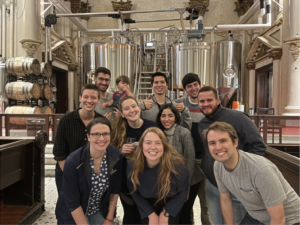
The Modell lab including Josh, back left.
Modell has started his own lab at Johns Hopkins University. He and his lab members continue to study fundamental CRISPR mechanisms in their native bacterial context. Modell thinks he is still finding his footing in terms of his mentoring style and establishing lab culture. In listening to Modell it’s clear there are many aspects of Marraffini that serve as guide posts as he refines his own approach.
The Evolution of Scientific Ideas
Steitz advises current JCC Fellows to not worry about exactly how their current research connects with human health. Reflecting on her decades of experience defining fundamentals of RNA biology, she is thrilled that this knowledge set the stage for the recent Covid-19 mRNA vaccines. Yet there is no way she could have predicted this outcome when she was conducting the research.
This lineage, and their scientific contributions to RNA biology and CRISPR genetic engineering, provide strong evidence for the foundational role of basic scientific research for medical breakthroughs.
Research from the Mitton-Fry lab shows how temperature-dependent RNA structures contribute to pathogenic infections. The research from the Sontheimer, Marraffini and Modell labs, among others, provide fundamental insight into CRISPR in the native bacterial context, as well as genetic engineering applications. In fact, Marraffini contributed to the first study to demonstrate CRISPR application in human cells, published in 2013. Fast forward to 2023 and CRISPR-based therapies treat sickle-cell anemia and b-thalassemia. Additional CRISPR therapies are in development for cystic fibrosis, muscular dystrophy, Huntington’s disease, and numerous different types of cancers. It is only a matter of time until at least some of these breakthroughs are widely used in the clinic.
Thank You Dr. Joan Steitz!
The scientists and stories featured through the lens of JCC in this article represent a mere fraction of the impact Dr. Joan Steitz has made on the broader scientific community. Through her lab, collaborations, tireless advocacy for women in science, and longstanding contributions to The Jane Coffin Childs Foundation, Dr. Steitz has made an indelible mark on the modern era of biomedical research!